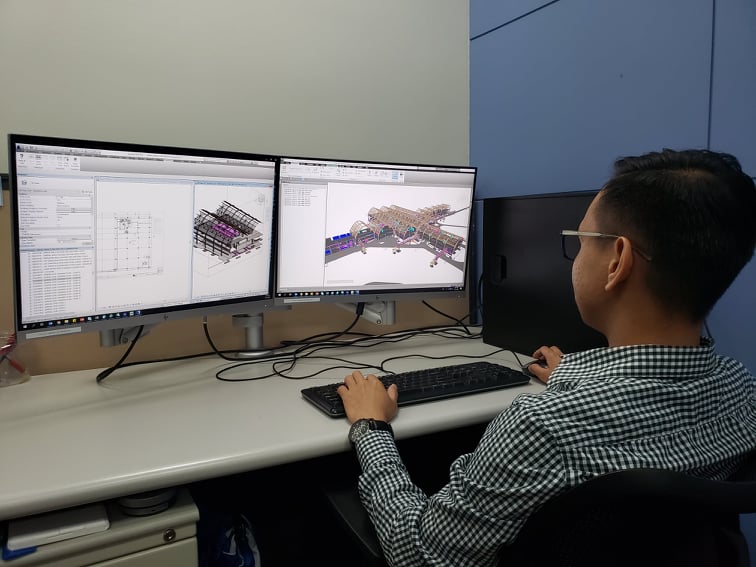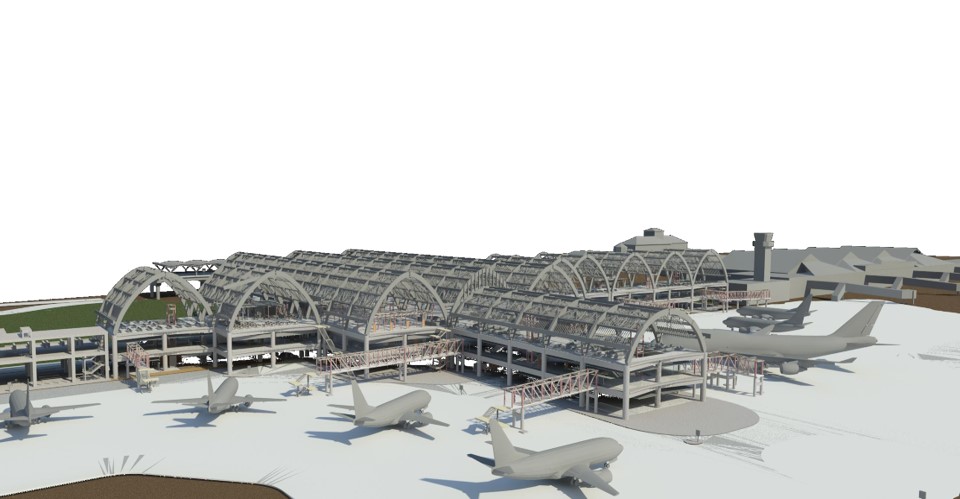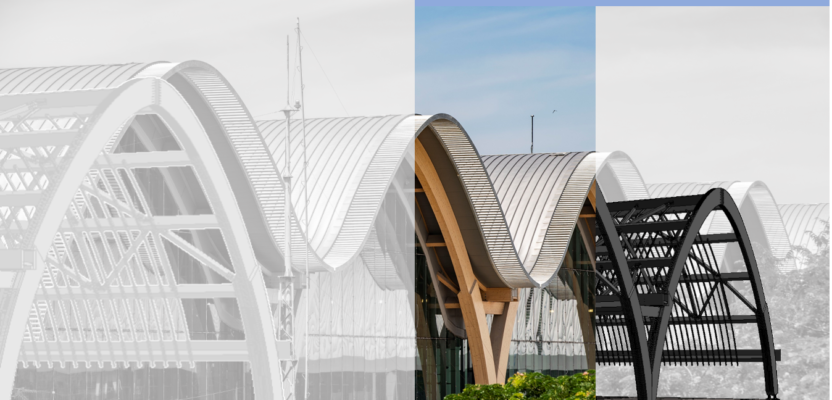Designed using building information modeling, Mactan-Cebu International Airport is a tribute not only to technology but also team collaboration and creativity.
Featured image: Photomontage (by Marcel Lam) shows the BIM model combined with an actual photo of the Mactan-Cebu International Airport’s roof.
Everything about the design of the newly built Terminal 2 at the Mactan-Cebu International Airport is near perfect, from the extensive use of exposed wooden beams that give a natural tropical feel to the built-up space, to the construction of arched ceilings with skylights that allow sunlight to enter its vast interior. Even the undulating metal roof has been intricately rendered, calling to mind the rolling waves that surround Cebu Island.
So it should come as no surprise that this creatively designed airport in the Philippines has been winning international awards, including last year’s most coveted prize: the International Architecture Award in the Airports and Transportation Centers category.

Jessica Pawlowski. © Arup
Yet for Jessica Pawlowski and Demetrio Cruz, one award might just be the closest to their hearts. The two BIM experts and civil engineers at Arup, the international engineering and architecture services company, steered a diverse team in creating the airport’s building information model (BIM). Their team’s innovative BIM efforts were recognized by the judges at the 2015 Autodesk BIM Awards.
“I think that one of the winning features of the airport project was its level of BIM advancement, even though we were still at the design development stage,” shares Cruz, the lead structural modeler and BIM manager for the project. “We developed efficient BIM workflows and tools at that time when there were not many available references yet.”
For Pawlowski, it was their design philosophy that made them win. “Personally, I think it was about the ethos of our approach to reduce time wastage, focus on established design principles and collaboration, and not treating the BIM model as the be-all and end-all.”
With BIM as the main tool for the airport’s design transformation, Pawlowski, who was Arup’s lead designer as well as a structural lead, said, “I think that you get better quality facilities and architecture with BIM, including better service and savings in the long run throughout the entire supply chain.”

Demetrio Cruz working on the BIM model of the airport.
Designing with BIM
Over the years, the term Building Information Modeling has been given many definitions and interpretations, a clear indication of its broadening design applications in the architecture, engineering and construction (AEC) sectors. Numbers from the latest survey of companies in the UK show that BIM awareness and adoption grew from more than 10 percent in 2011 to around 70 percent in 2019.
“BIM is business as usual for us at Arup,” says Pawlowski. “When you are trying to achieve world-class architecture with a limited budget and tight timescale, BIM helps us resolve issues in design to avoid them later in construction.”
BIM, however, should not be viewed simply as a software that allows people to create sleek-looking 3D models of buildings. While BIM may not always speed up the design phase, adopting it throughout should always speed up construction. BIM should be seen as a system that provides different actors a way to efficiently exchange building information resulting in a more cost-effective construction process.
“BIM is a tool and it’s about how that tool is used to enhance coordination and understanding of a project that makes it useful,” explains Pawlowski.
 When using BIM in projects, the crucial element is not just the 3D model itself, but the information that has been created, managed and shared among project managers, engineers, operators, contractors, and architects. As such, the BIM environment can be applied to any design project. “A project does not need to be unique to do BIM modeling,” says Cruz.
When using BIM in projects, the crucial element is not just the 3D model itself, but the information that has been created, managed and shared among project managers, engineers, operators, contractors, and architects. As such, the BIM environment can be applied to any design project. “A project does not need to be unique to do BIM modeling,” says Cruz.
Team collaboration in BIM is a must
Originally built to accommodate 4.5 million passengers per year, the Mactan-Cebu International Airport has been receiving an overwhelming influx of 7 million passengers annually. To stem this problem, the team at Arup worked with architects from Integrated Design Associates (IDA) to draw up plans for the much-needed airport transformation. The design challenge was to expand the existing airport to hold 15.8 million passengers per year, or even more.
We collaborated with the architects at IDA and with other consultants,” says Pawlowski. “Arup’s daily core BIM team was just over two dozen persons, with the entire team at around 150-persons strong. A majority of us touched and used the BIM model in different stages.”
The dominant part of the airport’s transformation is its new terminal, a three-story building with exposed arches that show a curvilinear ceiling. Topping the entire structure is a wave-shaped metal roof covering 65,500 square meters. The team also developed a wider airport plan, including reconfiguration and redesign of aprons, taxiways, existing facilities, and the landside road network.
As the wider design team was globally distributed (Austria, Cebu, Delhi, Hong Kong, Manila, and Singapore) and had varying BIM skills, there was a high potential for poor execution, especially when communication can become complex due to different time zones and fluctuating quality of Internet speed. With these challenges facing them, collaboration is undeniably paramount.
Collaboration is a must in doing any BIM project,” says Cruz. “For this project, we had weekly meetings to discuss issues that have impact on the design. Doing so in the early stages helped us to keep the BIM model coordinated until the end.”
Together, the team worked in Arup’s BIM-lite environment, where team members simplified processes and focused on developing smart workflows, automation, and parametric modeling. Members collaborated closely with the architects, often using multidisciplinary 3D visualizations to communicate different design options to the client, highlighting each option’s pros and cons. Using BIM, the team was able to pinpoint issues that could have an impact on construction.
“For example, to identify the building height limitation of the terminal, we did a 3D line-of-sight analysis,” says Pawlowski. The line-of-sight from the airport’s control tower was assessed by creating BIM/3D massing models of the airport’s roof, adding planes on the taxiway, and viewing it in the virtual airport. BIM was also used to discuss various options that could improve passenger movement in the departure and arrival areas.

The virtual airport created with BIM/3D massing models showing the control tower, roof arches and shading structure, with planes on the taxiway. © Arup
“Graphic representation using BIM made it far easier for us to communicate with collaborators and agree on key parameters,” adds Pawlowski.
Working with a BIM plan while fostering creativity
Essentially all BIM projects start with a BIM Execution Plan (BEP), a valuable document that defines how the information modeling aspects of a BIM-enabled project will be carried out. The BEP comes in handy to optimize work by minimizing errors, redundancies and gaps in the flow of information.
For the Mactan-Cebu project, Cruz says the BEP was first decided with the other collaborators. “We did not have a required BEP initially, and therefore we agreed on the key features together with the architects and client before embarking on any modeling.”
Cruz then describes the team’s general BIM workflow in a nutshell: “To start with, we worked in the same correct coordinate location so that it would be easy to link models in later stages. Secondly, we determined the divisions of sheets to be used in all models to make sure the drawings are coordinated throughout the different users and disciplines. This remained constant throughout the project and ensured easy use of drawings on site where the supply chain was not entirely BIM-enabled.”
He further adds that the modelers functioned as a leading part of the team. Communicating what to build is foremost and the team was always taking into consideration other disciplines to foresee and evaluate potential conflicts in the design. “We immediately flagged up the person responsible whenever we saw clashes.”
For the internal and external exchange of BIM models, Cruz says they kept records of all models issued and received. “We checked the models that we received to make sure they are usable and that their updates are based on what we already agreed on during meetings,” he says. “Another thing that we took advantage of is the automation of processes to streamline repetitive workflows.”
Although sticking to a BIM execution plan can sometimes be regarded as rigorous, it should not limit the creativity of team members. Many industry observers claim that BIM is fostering digital-savvy operators but at the same time stifling their ability to produce original and useful ideas. Could better collaboration and collective decision-making within the BIM process enhance creativity?
“One important factor to successfully deliver a BIM project is to release the team’s creativity while focusing on communication,” says Pawlowski. “It is possible to deliver models for the entire project lifecycle without being so overbearing with project management and procedures. This chokes creativity and bogs down designers. You will find that designers enjoy their work more when they are able to focus on design, and not on the process. And when your team is having fun, they do far better designs.”
Building trust, not just models
With the airport’s BIM-based design, the team was able to carry out quicker and more efficient testing of the inter-relationships between competing airport requirements, including issues in the tarmac’s topography, the terminal floor heights, and the airport’s road networks.
Pawlowski shares that for this project, they abandoned the traditional BIM formula and rethought how to best approach the assigned tasks. “On previous projects, concept design had been done in 2D and only moved to 3D later. In this project, 3D modeling in REVIT was adopted by the entire team from concept through delivery.”
Aside from doing away with 2D CAD, the team also reduced wasted effort and employed a more efficient use of time by removing the need for formalized clash detection reports. Instead, they focused on fostering communication and relationships, as well as building trust between all parties.
“I think our success is largely down to trust. We ended with zero clashes in a very short period,” says Pawlowski.
To cultivate trust, regular workshops were held to keep the team posted on everyone’s progress, while models were shared only when key components had been updated so that less time was wasted. “We often used overlays of models, live in REVIT, and edited directly while discussing details together. Doing so allowed us to ensure that everyone was on the
same page and had clear actions to validate these adjustments in an agreed timescale,” says Pawlowski.
The team also chose to share models less frequently, and when they did so, they made sure that each model share counted, using updated notes and logs to keep track of big changes. Furthermore, members were encouraged to bring their skills up to date by learning on the job. Models were likewise developed to suit the member’s design development preferences and automation abilities.
“We encouraged the wider team to implement as many efficiency measures as possible, including automation and inbuilt features of REVIT. This freed us to go directly to a higher level of development (LOD 300) if it suited or to step through the massing approaches of LOD 100 or 200 as necessary,” Pawlowski explains.
She also shares that instead of aiming to create clash-free models at every phase, the team resolved key clashes before they manifested at later project stages by keeping communication constant and by focusing on good design principles. “This may sound counter intuitive, but it forced the entire team to take charge of their work towards a coordinated design. This approach required the team to rely on their design experience and to proactively communicate,” she says.
According to Pawlowski, prioritizing areas and parts of the designs to be fully coordinated proved a far more effective approach. “Through this project, we proved that success and quality design is possible if you work together and each team member takes responsibility so that they can be proud of their work,” she says.
Delivering a world-class BIM
Now that the airport project is complete, Cruz says being part of the team makes him proud, adding that their hard work paid off with all the awards the project has received. Asked about which part of the airport was both interesting and challenging to render, Cruz points to the distinctive arches of the roof. “There is a limitation in working with curve elements in Revit, but we were able to automate that by using in-house tools while developing add-ins and workflows to aid the process,” he says.
Pawlowski also chose the roof as the feature that most challenged her. “The multi-discipline zones near the departures deck were challenging, especially where the roof arches intersected through difficult architectural detailing,” she says. She then explains they had to make sure those areas worked well so that they do not end up being poorly installed during construction, highlighting the importance of not undermining the interplay between aesthetics and functionality of the design. “I think we succeeded by spending time to get those details to work in 3D because they look amazing now that the terminal has been built.”
Every modeler knows it’s hard to design iconic architecture in a short period of time. But Pawlowski says it makes her happy to be part of the group that designed the BIM model for the airport.
“Delivering such ambitious architecture, especially employing BIM techniques, to do so cost effectively for the people of Cebu and their many visitors, makes me particularly proud of our work,” she says. “The most rewarding aspect would be the team effort right across the project team. Look what international and local collaboration can achieve.”
With BIM becoming the global language of the AEC sector, expect it to change how infrastructures will be designed in the future. For now, Pawlowski believes that BIM is here to stay, expanding boundaries that will lead to more automation and parametric design. “In this airport project, we pushed the envelope on how to deliver excellent results with BIM, and that is always appreciated. It helps move the industry forward step by step.”

